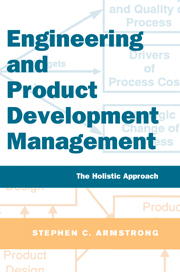Book contents
- Frontmatter
- Contents
- List of figures and tables
- Forewords
- Preface
- Acknowledgments
- Layout of book at a glance
- PART 1 UNDERSTANDING ENGINEERING PROCESS MANAGEMENT
- PART 2 APPLYING ENGINEERING PROCESSES TO PROGRAM MANAGEMENT
- 4 Roles and responsibilities
- 5 Approach to program and project management
- 6 An integrated team member's guide to performing a task
- 7 Program structuring and planning
- 8 Risk assessment
- 9 Program initiation and execution
- 10 Program reviews
- 11 Engineering change management and product data management
- PART 3 DEPLOYING ENGINEERING PROCESS MANAGEMENT
- PART 4 APPENDIXES
- Glossary
- References
- Index
7 - Program structuring and planning
Published online by Cambridge University Press: 05 April 2014
- Frontmatter
- Contents
- List of figures and tables
- Forewords
- Preface
- Acknowledgments
- Layout of book at a glance
- PART 1 UNDERSTANDING ENGINEERING PROCESS MANAGEMENT
- PART 2 APPLYING ENGINEERING PROCESSES TO PROGRAM MANAGEMENT
- 4 Roles and responsibilities
- 5 Approach to program and project management
- 6 An integrated team member's guide to performing a task
- 7 Program structuring and planning
- 8 Risk assessment
- 9 Program initiation and execution
- 10 Program reviews
- 11 Engineering change management and product data management
- PART 3 DEPLOYING ENGINEERING PROCESS MANAGEMENT
- PART 4 APPENDIXES
- Glossary
- References
- Index
Summary
In this chapter, we will examine an approach to top-down planning involving three principal activities:
❍ Confirming the program scope and environment
This activity includes understanding the program objectives and scope, the technical and work practice requirements, and the cost and scheduling constraints. All of this is critical for product and functional directors.
❍ Structuring the program
This activity involves defining the general approach to organizing and managing the program and developing a high-level program plan.
❍ Developing the detailed workplans
This activity includes planning and estimating, at a detailed level, the outputs required to fulfill each of the program's subphase objectives.
We will also describe these planning activities and showthe important linkages and considerations in using a top-down planning methodology. Figure 7-1 illustrates the results of these activities. The remainder of this chapter describes them in more detail.
Planning an advanced engineering program effectively is an essential prerequisite to delivering a quality product definition. With a firm understanding of the customer's business and a well-thought-out program plan, the product and functional directors can maintain perspective and a clear direction in the midst of rapid change. They can also remain flexible enough to accommodate requests for changes to the product's specifications or modifications necessitated by changing technology.
Program structuring and planning is accomplished by tailoring the Define process to fit the unique characteristics of the program. It defines the work that must be performed by identifying which tasks and worksteps in the workplan templates are required to complete the project.
- Type
- Chapter
- Information
- Engineering and Product Development ManagementThe Holistic Approach, pp. 98 - 118Publisher: Cambridge University PressPrint publication year: 2001



